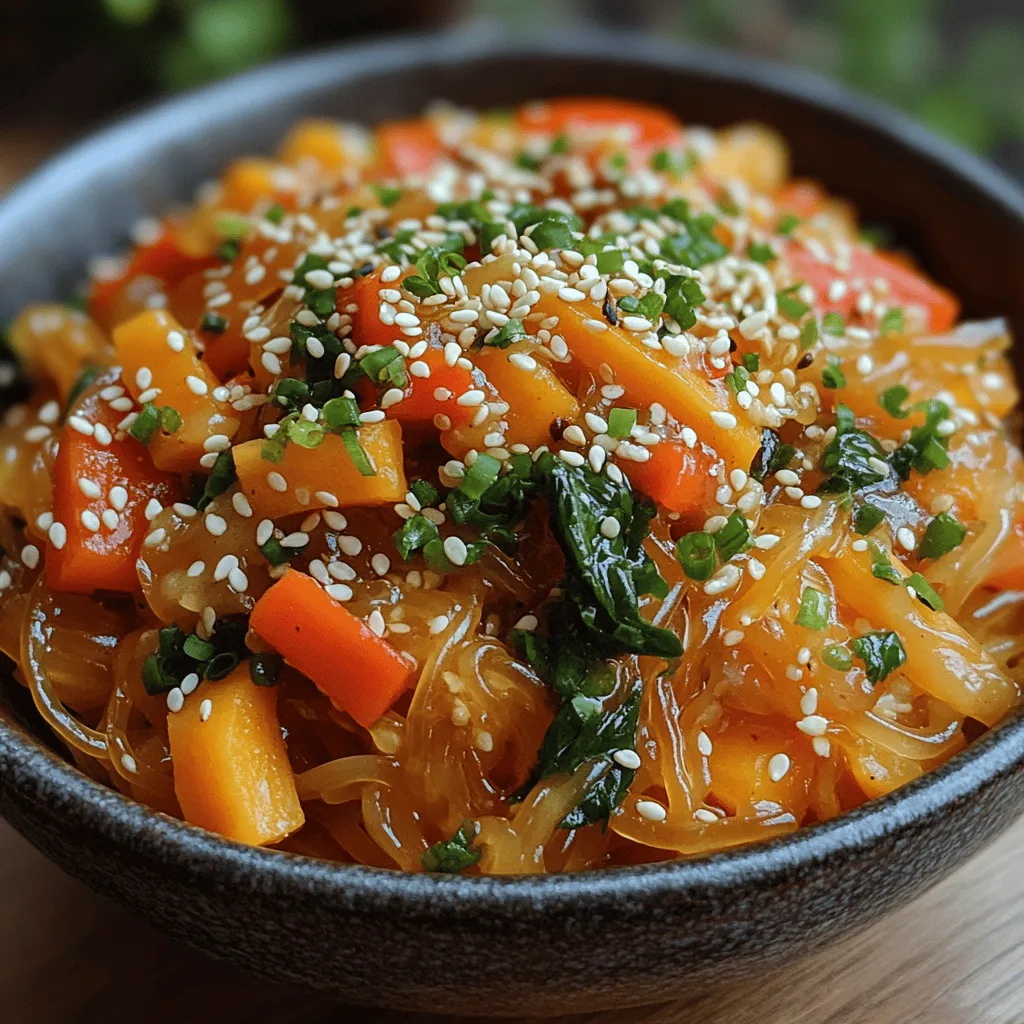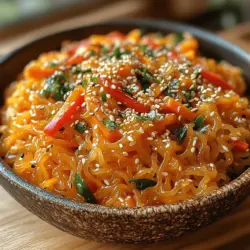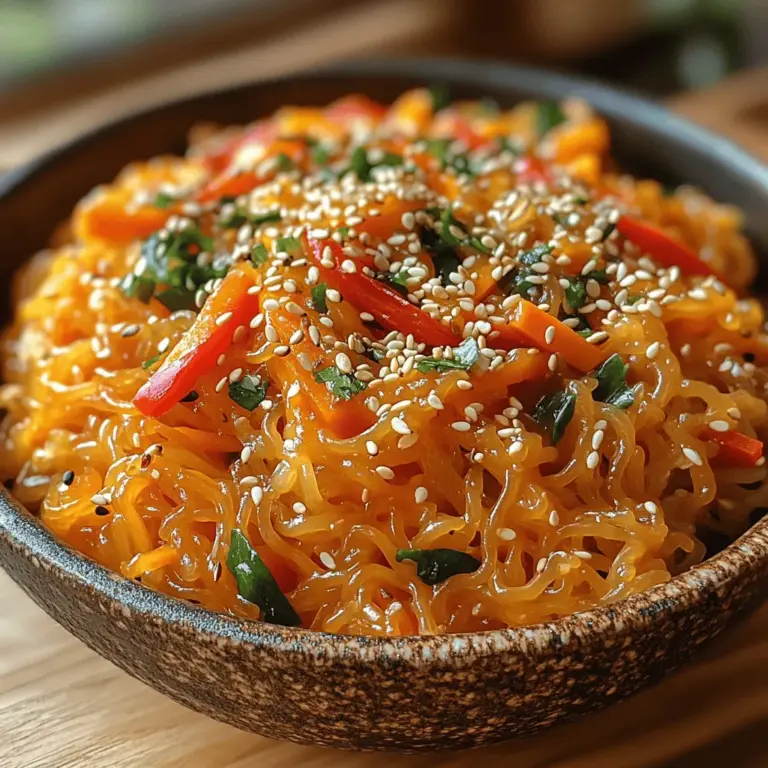Introduction
Exploring the world of Asian cuisine often leads us to the delightful dish known as Japchae, a Korean favorite that showcases the unique texture and flavor of sweet potato starch noodles. Japchae, which translates to “mixed vegetables,” is a versatile and vibrant dish that combines chewy noodles with an array of colorful vegetables, enhanced by a savory sauce that tantalizes the taste buds. In this article, we will walk you through each step of the recipe for Savory Sweet Potato Japchae Delight, delve into the nutritional benefits of the ingredients, and explore the cultural significance of Japchae. Whether you are a seasoned cook or a culinary newbie, this comforting dish is sure to impress at your dinner table.
Understanding Japchae: A Cultural Overview
Origins of Japchae
Japchae has a rich history in Korean cuisine, dating back to the 17th century during the reign of King Gojong. Originally, it was served as a royal dish, created for special occasions and celebrations. The dish was traditionally prepared using wheat noodles, but over time, sweet potato starch noodles became the preferred choice due to their unique texture and ability to absorb flavors. Japchae gained popularity and evolved from a celebratory dish to a beloved everyday meal enjoyed by families across Korea.
Today, Japchae is often served during significant Korean celebrations such as birthdays, weddings, and holidays like Chuseok, the Korean harvest festival. It symbolizes prosperity and abundance, making it a fitting addition to any festive table. The combination of colorful vegetables and the glossy appearance of the noodles represents harmony and balance, which are essential elements in Korean culture.
Key Ingredients and Their Importance
The beauty of Japchae lies not only in its taste but also in the variety of fresh ingredients used in its preparation. The star of the dish is undoubtedly the sweet potato starch noodles, known as “dangmyeon,” which are gluten-free and offer a chewy texture that complements the crispness of the vegetables. These noodles are made from sweet potato starch, giving them a slightly sweet flavor that pairs perfectly with savory sauces.
In addition to the noodles, Japchae typically features a vibrant assortment of vegetables, including:
– Carrots: These add a natural sweetness and crunch to the dish.
– Spinach: Nutritious and earthy, spinach provides a pop of color and a tender texture.
– Bell Peppers: Available in various colors, bell peppers bring sweetness and a crunchy bite.
– Onions: Sautéed onions add depth and richness to the overall flavor profile.
– Mushrooms: Shiitake or button mushrooms contribute an umami taste and a meaty texture.
The sauce used in Japchae is a harmonious blend of soy sauce, sesame oil, and a hint of sugar, creating a savory and slightly sweet glaze that elevates the dish. Each ingredient plays a vital role in achieving the perfect balance of flavors, making Japchae a truly delightful culinary experience.
The Versatility of Japchae
Customizing Your Japchae
One of the best aspects of Japchae is its versatility. While the traditional recipe calls for specific vegetables and proteins, you can easily customize it to suit your taste preferences or dietary restrictions. For a vegetarian or vegan version, simply omit any meat and load up on seasonal vegetables like zucchini, broccoli, or snap peas. You can also experiment with different types of mushrooms to add depth and heartiness to the dish.
If you’re looking to add protein, consider incorporating tofu, beef, chicken, or shrimp. Each option infuses the dish with its unique flavor while still allowing the sweet potato noodles to shine through. The beauty of Japchae lies in its ability to adapt to whatever ingredients you have on hand, making it a perfect dish for utilizing leftovers or seasonal produce.
Serving Suggestions
Japchae can be served in various ways, making it a versatile addition to your dining table. It can be enjoyed as a standalone meal, thanks to its well-rounded combination of carbohydrates, vegetables, and protein. Alternatively, you can present Japchae as a side dish alongside other Korean favorites such as bulgogi (marinated grilled beef), kimchi, or Korean fried chicken.
For a more casual gathering, consider serving Japchae in small portions as part of a Korean-inspired feast, complete with rice, pickled vegetables, and other banchan (side dishes). Its colorful presentation and delightful flavors will surely impress your guests, making it a perfect choice for entertaining or family dinners.
Detailed Recipe Breakdown
Ingredients List
To prepare your Savory Sweet Potato Japchae Delight, you will need the following ingredients:
For the Japchae:
– 8 ounces sweet potato starch noodles (dangmyeon)
– 2 tablespoons vegetable oil (or sesame oil for extra flavor)
– 1 medium onion, thinly sliced
– 1 medium carrot, julienned
– 1 bell pepper (red or yellow), thinly sliced
– 1 cup fresh spinach, rinsed and drained
– 1 cup mushrooms (shiitake or button), sliced
– 2 cloves garlic, minced
– 2 green onions, chopped
– Sesame seeds for garnish (optional)
For the Japchae Sauce:
– 4 tablespoons soy sauce
– 2 tablespoons sesame oil
– 1 tablespoon sugar (or honey for a natural sweetener)
– 1 teaspoon ground black pepper
– 1 teaspoon red pepper flakes (optional for spice)
Preparation Steps
The preparation of Japchae involves several key steps that ensure each ingredient is cooked to perfection, maximizing flavor and texture.
Soaking the Noodles
The first step in preparing your Japchae is to soak the sweet potato starch noodles. Begin by placing the noodles in a large bowl and covering them with hot water. Allow the noodles to soak for about 30 minutes, or until they have softened but are not fully cooked. This step is crucial, as it helps achieve the ideal chewy texture that makes Japchae so enjoyable.
Once the noodles are adequately soaked, drain them and rinse under cold water to stop the cooking process. Cut the noodles into manageable lengths with kitchen scissors, making them easier to stir-fry later. This will also help prevent them from clumping together during cooking.
Sautéing the Vegetables
With the noodles prepped, it’s time to sauté the vegetables. Begin by heating 2 tablespoons of vegetable oil in a large skillet or wok over medium-high heat. Once the oil is hot, add the sliced onions and sauté for about 2-3 minutes until they become translucent.
Next, add the julienned carrots and bell peppers to the skillet. Stir-fry the vegetables for an additional 3-4 minutes, allowing them to soften while maintaining their vibrant colors. Follow with the sliced mushrooms and minced garlic, cooking for another 2 minutes until the mushrooms are tender and fragrant.
Finally, add the fresh spinach and stir until it wilts, which should take just about a minute. Once all the vegetables are cooked, remove them from the skillet and set them aside. This step not only enhances the flavors of the vegetables but also allows you to create a beautiful medley of colors in your Japchae.
—
This marks the end of the first part of our journey into crafting the Savory Sweet Potato Japchae Delight. In the next part, we will delve deeper into combining the ingredients, finishing touches, and tips for achieving the perfect dish. Stay tuned!

Cooking Instructions: Maintaining Freshness and Crunch
To create the perfect Savory Sweet Potato Japchae, achieving the right texture in your vegetables is crucial. Each vegetable should be cooked just enough to maintain its natural crunch while also absorbing the flavorful sauce. Below, we detail the ideal cooking times for each ingredient.
1. Sweet Bell Peppers: Slice these into thin strips. Sauté them for about 2-3 minutes. You want them to soften slightly while retaining their bright color and crispness.
2. Carrots: Cut carrots into julienne strips for a finer texture. They typically require about 3-4 minutes of cooking. This time will allow them to become tender yet still crunchy.
3. Spinach: Fresh spinach cooks quickly, so add it to the pan toward the end of your vegetable cooking time. Toss it in for about 1-2 minutes until just wilted, preserving its vibrant green color and nutrients.
4. Mushrooms: Thinly sliced mushrooms should be cooked for about 4-5 minutes. This cooking time helps release their moisture and enhances their flavor without turning them mushy.
5. Onions: Sliced onions can be sautéed for 3-4 minutes until they become translucent and aromatic, which will infuse a wonderful base flavor into the dish.
By adhering to these cooking times, you ensure that each vegetable contributes its unique texture and taste to your Japchae.
Creating the Sauce
The sauce is the heart of any Japchae and is what sets this dish apart. A well-balanced sauce enhances the natural flavors of the vegetables and the sweet potato noodles. To create the sauce, follow these steps:
1. Ingredients for the Sauce:
– 3 tablespoons soy sauce (or tamari for a gluten-free option)
– 1 tablespoon sesame oil
– 1 tablespoon sugar (brown sugar or coconut sugar works well)
– 1 teaspoon minced garlic
– 1 teaspoon rice vinegar (optional for a tangy kick)
– A pinch of black pepper
2. Making the Sauce:
– In a small bowl, combine the soy sauce, sesame oil, sugar, minced garlic, and rice vinegar. Whisk together until the sugar is dissolved and the mixture is well combined.
– Taste the sauce. It should be savory with a hint of sweetness. Adjust the ingredients according to your preference; for instance, add a bit more sugar for sweetness or extra soy sauce for saltiness.
This sauce not only adds flavor but also brings together the various components of your Japchae, ensuring a delightful bite every time.
Combining Ingredients
With your noodles, vegetables, and sauce prepared, it’s time to bring everything together:
1. Cooking the Noodles: Cook the sweet potato starch noodles according to the package instructions. Typically, they will take about 6-8 minutes to become tender yet chewy. Drain and rinse them under cold water to stop the cooking process and prevent them from sticking.
2. Combine Everything:
– In a large skillet or wok, heat a teaspoon of sesame oil over medium heat. Add the cooked noodles, followed by the sautéed vegetables.
– Pour the sauce over the noodles and vegetables. Using tongs or chopsticks, gently toss everything together until the noodles are well coated with the sauce and mixed evenly with the vegetables. This step is crucial for ensuring that the flavors meld into every strand of noodle and piece of vegetable.
3. Final Cooking: Stir-fry the combined mixture for an additional 2-3 minutes. This brief cooking time helps the noodles absorb the sauce and allows the flavors to deepen.
Nutritional Benefits of the Ingredients
Japchae is not only a feast for the senses but also a healthy meal option. Let’s explore the nutritional benefits of the key ingredients:
Sweet Potato Starch Noodles
Sweet potato starch noodles, known as dangmyeon, are gluten-free and low in calories compared to traditional wheat noodles. They are rich in complex carbohydrates, which provide sustained energy. Additionally, they are high in fiber, promoting digestive health and keeping you fuller for longer.
Vegetables Galore
The variety of vegetables in Japchae adds a wealth of nutrients:
– Bell Peppers: Packed with vitamins A and C, bell peppers are known for their antioxidant properties, which help combat free radicals in the body.
– Carrots: A great source of beta-carotene, carrots support eye health and are rich in antioxidants that promote overall health.
– Spinach: This leafy green is loaded with iron, calcium, and vitamins K and A. It’s excellent for maintaining strong bones and supporting your immune system.
– Mushrooms: Mushrooms offer a unique combination of vitamins and minerals, including B vitamins, selenium, and antioxidants, making them a nutritious addition to any meal.
Healthy Fats from Sesame Oil
Sesame oil not only enhances the flavor of your Japchae but also contributes healthy fats. It contains polyunsaturated and monounsaturated fats, which are beneficial for heart health. Additionally, sesame oil is rich in antioxidants, particularly sesamolins, which can help lower cholesterol levels.
Presentation and Garnishing
The visual appeal of your dish can elevate the dining experience. Here are some tips for presenting your Japchae attractively:
Creating an Appealing Platter
1. Use a Large Serving Bowl: Choose a bowl that allows the colorful noodles and vegetables to be displayed prominently.
2. Layering: When serving, consider layering the noodles first, then adding a generous amount of vegetables on top, showcasing the vibrant colors.
3. Contrast: The contrast of colors is vital. Ensure that the bright greens of spinach, the reds of bell peppers, and the orange of carrots are visible against the dark noodles.
Garnishing for Flavor and Aesthetics
1. Sesame Seeds: Sprinkle toasted sesame seeds over the top of the Japchae for added texture and a nutty flavor.
2. Green Onions: Finely chop green onions and scatter them as a garnish. This not only enhances the dish’s visual appeal but also adds a fresh, zesty flavor.
Conclusion
The Savory Sweet Potato Japchae Delight transcends being a mere meal; it embodies a rich cultural heritage and offers a nutritious, customizable dish that can cater to various dietary needs. Its beautiful presentation and harmonious flavors make it suitable for any occasion, from a comforting family dinner to an impressive gathering with friends.
With its vibrant colors, diverse textures, and delightful taste, this dish is sure to be a hit. Embracing the flavors of Japchae allows you to bring a piece of Korean cuisine into your home, creating a memorable culinary experience for you and your loved ones. So, gather your ingredients, follow the steps, and enjoy the satisfaction of creating this beloved dish that will leave your guests asking for seconds.

